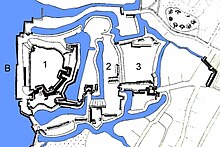Kariya Castle
| Kariya Castle | ||
|---|---|---|
|
Kariya Castle, access |
||
| Alternative name (s): | Kijō ( 亀 城 ) | |
| Castle type : | Hirayamajiro (hill castle) | |
| Conservation status: | Moats partially preserved | |
| Place: | Kariya | |
| Geographical location | 34 ° 59 '19 " N , 136 ° 59' 4.6" E | |
|
|
||
The Kariya Castle ( Japanese 刈 谷城 , Kariya-jō ) is located in the city of Kariya in Aichi Prefecture . In the Edo period , the Doi last resided there as Fudai daimyo .
Lords of the castle in the Edo period
- From 1600 a branch of the Mizuno with an income of 30,000 Koku ,
- from 1616 another branch of the Mizuno with 20,000 koku,
- from 1632 the Fukōzu-Matsudaira with 30,000 Koku,
- from 1649 a branch of Hisamatsu-Matsudaira with 20,000 koku,
- from 1651 a branch of the Inagaki with 23,000 Koku,
- from 1702 a branch of the Abe with 16,000 koku,
- from 1710 a branch of the Honda with 50,000 Koku,
- from 1712 the Miura with 23,000 Koku,
- from 1747 a branch of the Doi with 23,000 koku.
history
Kariya Castle was built in 1533 by the local Mizuno Tadamasa ( 水 野 忠 政 ; 1498–1543). Since Tadamasa's son Nobumoto had joined Oda Nobunaga's side in the Battle of Okehazama in 1560 , he was attacked by the Imagawa , who destroyed his castle. Nobunaga later suspected that Nobumoto had a secret connection with the Takeda , and the latter committed suicide. Thereafter, Sakuma Nobumori ( 佐 久 間 信 盛 ; 1528–1582) was lord of the castle for a while.
But then Tadashige ( 忠 重 ; 1541–1600), Nobumoto's younger brother, took over the castle again as lord of the castle. His son Katsunari ( 勝 成 ; 1564–1651) rebuilds the castle in a modern style.
The attachment
Kariya Castle is located at the northern end of the elongated, river-like Iura Bay ( 衣 浦 湾 , -wan ; B) on a hill. In the east and south around the central area, the Hommaru ( 本 丸 ; 1), the second area, the Ni-no-maru ( 二 ノ 丸 ; 2), joined. Further to the east follows the third area, the San-no-maru ( 三 ノ 丸 ; 3). Most of the castle was protected by earth walls ( 土 塁 , dorui ), only a few places were rock walls.
The Hommaru was protected in the northwest and southeast by a two-story watchtower, the residence of the lord of the castle was in San-no-maru. There was no castle tower in the Edo period , its function was taken over by the watchtower on the northwest corner.
After the Meiji Restoration in 1868, all of the castle's buildings were demolished. The Hommaru and part of the Ni-no-maru became a public park in 1936 under the alternative name of the castle, Kijō-Park ( 亀 城 公園 , Kijō-kōen ). The castle area is known for its cherry blossom.
literature
- Owada, Yasutsune: Kariya-jo. In: Miura, Masayuki (ed.): Shiro to jinya. Tokoku-hen. Gakken, 2006. ISBN 978-4-05-604378-5 , p. 100.


